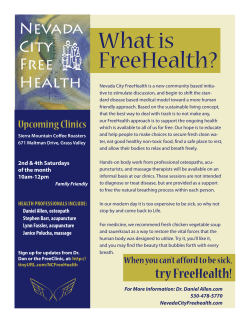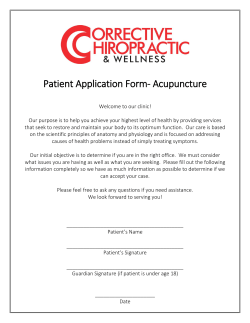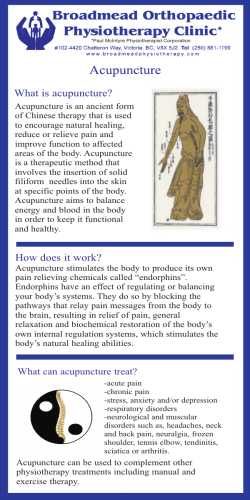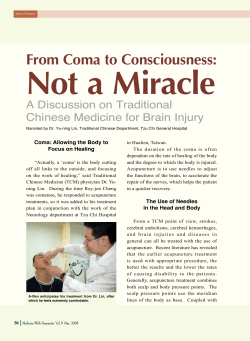
Document 192401
NAJOM perfection as possible and using a small piece of leather to wipe off any fat and residue from the skin penetration. Later, I realized the tedious task of handling such fine needles (he usually How to Perform Magic 14 NUMBER 39 in a Japanese fasting center. I add some yoga and stretching to it. Afterwards, I swing a fou rpound bokken (wooden sword) 2ootimes. As of by Takamatsu Bunzo this year, 1have been adding meditation, whic h It has been over 25 years since I started this is that what patients really want from us is th e I think is going to be critical. My observation used needlesofo.14mm in diameter) was aimed at developing my sensitivity and dexterity. Prior VOLUME to sterilizing them in the autoclave, the master business. For many years, I kept myself busy ability to tell instantaneously what's wrongwi th himself then sharpened each needle manually improving my abilities while at the same time them and fix it on the spot. In other words, the y by grinding it on a small oilstone. He wanted making living. For the last two or three years, want magic. We are able to perform magic eve ry to keep the needles in the best shape for the my practice has been very busy, averaging 30 patients a day. once in a while. The only difference between patients. He performed this work as a sort of more constantly. Intuition is essential to th e daily ritual or spiritual ceremony. Eventually, I began sharpening my own needles everyday and after about two years became very good at it. However, during the entire 10 years of my apprenticeship, the master never once let me sharpen his needles. After I had graduated from acupuncture school, passed the national exam, and received my acupuncture license, the master let me make house calls to certain patients. I was only 21 years old - much too young in the eyes of most Japanese patients to be trusted as an acupuncturist. But once they received treatment, they were convinced of my skill. the masters and us is that they can perform it Outwardly, it has been steady gradual progress; performance of our magic. inwardly, it has been constant struggle. What I yearned for most was an acupuncture mentor Masters like Sawada Sensei, Fukaya Sense i, with whom I could consult when I had ques· Manaka Sensei, and Nagano Sensei were all tions, doubts, and worry. I needed a mentor very intuitive. I used to think they were just especially when I lost my self·confidence. I born that way. Now I think there is more to it often wondered how other people built their than that. Another factor common amongthem self-confidence. My way of enhancing rny skills is that they are very knowledgeable. Before was to read and re-read books, and occasion- they became intuitive, they must have studied ally, to participate in workshops. Workshops a great deal. It's obvious from their writings. were rare opportunities when I could observe Intuition, considered primarily a right-bra in masters and otherwell-trained acupuncturists. function, seems to be developed through t he It is not hard to imagine that one could build hard work of the left brain. However, I have up his/her confidence byobservingteachers in observed another important factor. What drove Afterfiveyearsofapprenticeship, I felt confident actual practice with actual patients everyday, as these masters to study so hard? I believe they enough to treat almost any kind of ailment and well as sharing the time and space with them. had either a very strong desire to heal their patient. However, I was still very young to be I think confidence is contagious. patients or a tremendous joy in what they did an independent therapist. So, I continued to work under Dr. Ohmura for another five years. Meanwhile, I continued studying medicine not only in Japanese but also in English, hoping that I would someday go abroad to promote my Japanese-style acupuncture and moxibustion. In 1981, after 10 years of apprenticeship (and treating more than 6o,ooo patients) I went to Canada and established Toronto's firstJapanese acupuncture clinic. Kokubo }unzo, LAc graduated from the Tokyo College :Jf Acupuncture and completed ten years of internship under Dr. K. Ohmura, a renowned Japanese acupuncturist. He is licensed to practice acupuncture in japan, and has been practising in Toronto since 1981. He has appeared on Global TV and CTV, and has also been a guest speaker at the medical depertment of the University of Toronto. In other words, as long as I have the passion The late renowned teacher and practitioner Dr. Nagano Kiyoshi once told me an acupuncturist should develop his or her own treatment on working on it, there is still a chance I can become like these masters. strategy by the age of 40. At over so now, I still don't have one. However, I have formed my own treatment style. In fact, the more comfortable I ward to the day when he/she excels his/ her I said I wished for a mentor. One can look for- have become with my own style, the less often I teacher. Since the teacher is also improving find myselfattendingworkshops, which is very this usually doesn't happen. Yet, one can sa . understandable because one does not get the that it is easier to go forward when you have same results as someone just by imitatingtheir what you are striving for right in front of you style.lttakes time to assimilate and internalize In my case, I establish my frame, break it, and a new approach. There is a reason we call our go on to establish a new frame that is a little profession a medical "art." As in any art, we greater than the last one.l just keep repeating eventually develop our own style. this process. It is not easy, but I am enjoying it. and my magic has just started. I wanted to describe my style, but have found out it is impossible to do in words. While I talk to a new patient, a treatment plan forms in my mind. The process is quite intuitive and hard to explain. The important thing for me is whether it works, and it usually does. My task is to keep this intuition sharp. Needless to say, maintaining good health is essential. Besides a healthy diet, I do a few things to keep myself in shape. Everymorninguponwaking,l doatypeofdo·in (Taoist exercise) that I learned over 30 years ago 22 to help my patients, I love doing it, and kee p Takamatsu Bunzo, DOM, LAc, graduated from the Kototama Institute, in Santa Fe, Ne Mexico, USA, in 1982. He has been practicing i" Dallas, Texas since 1988. His practice consis ts of acupuncture and moxibustion with some Sotai therapy and macrobiotic counseling.
© Copyright 2025





















